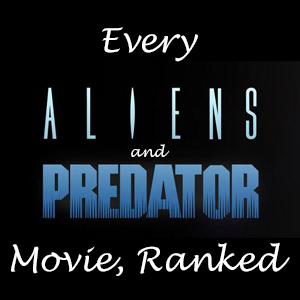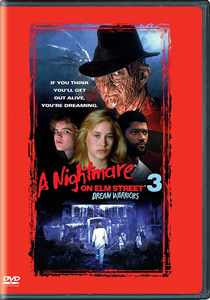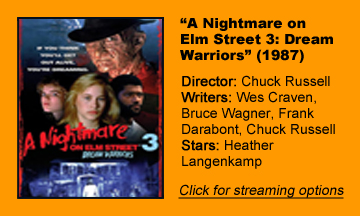From Sept. 18-Oct. 16, we’re looking back at the nine films of the “Nightmare on Elm Street” franchise. Next up is the third film, “A Nightmare on Elm Street 3: Dream Warriors” (1987):
Early cinematic super-powered team
“A Nightmare on Elm Street 3: Dream Warriors” is a fan favorite among the saga. A friend of mine notes that he loves the concept, but admits he can’t remember all the details.
I think that sums up the film well: It does have a great premise where a group of former Elm Street youths – now teenagers residing in a low-security mental institution – team up against Freddy (Robert Englund) in the dreamscape.
There’s nothing “Dream Warriors” does wildly wrong, but it’s flatter than it should be. This group doesn’t achieve that “Goonies” (or “Stranger Things”) level of warm outsider friendship.
It’s initially cool to see Patricia Arquette in the lead role as Kristen, who can pull her friends into her dreamscape, but I found myself frantically decreasing the volume whenever she screams. I would later love Arquette in “Medium,” but she hasn’t yet found that leading lady gravity.
It’s nice to see Heather Langenkamp return as Nancy Thompson, now a professional therapist, as this is six years after the events of the 1984 original. But Langenkamp looks like she’s playing dress-up in the role, and Nancy’s relationship with notably older fellow doctor Neil Gordon (Craig Wasson) is distractingly weird.
Not on same page
The screenplay (Wes Craven and Frank Darabont are among the four writers), settings, casting and direction are not on the same page. Scenes are written to suggest a romance between Nancy and Gordon — candlelit dinners, for example. Director Chuck Russell and the actors understandably don’t play the scenes romantically even though they are written and set-designed that way.
John Saxon, a lower-grade George Clooney of his day, returns as Nancy’s dad, a former police lieutenant now busted down to security guard status and drinking away his life. Nancy’s dad is part and parcel to that annoying issue wherein adult authority figures don’t believe the kids’ stories about Krueger (who is more often called “Freddy” now, rather than “Fred”).
Nancy calls this out during one of the many group sessions at the mental ward, noting that – for crying out loud – all of the kids here used to live on Elm Street. The lead doctor and administrator also refuse to believe the dreamscape connection, but Nancy and Gordon are well positioned to work around these hurdles, at least.
The nightmare sequences shine with their settings and gloriously cheesy but creative special effects. As noted, the teens’ interactions could stand to be more heartfelt, and it’s somewhat surprising that there’s no intentional humor whatsoever.
It’s funny in the abstract when Joey (Rodney Eastman) is lured away in the dream by a sexy version of the nurse he’s crushing on. But “Dream Warriors” never learns into the humor.

More amusing than scary
As I noted in my reviews of the first two entries, there’s something about Freddy’s playful attitude that is much more amusing than scary – and I think that’s truer than ever now that he can change shape and size.
But this might be personal bias, as apparently these films were viewed as scary back in the day. The imagery is certainly striking: This one features a vast hellscape where Joey dangles above a fiery pit.
Meanwhile, Nancy’s dad and Gordon feature in an intriguing B-plot wherein they aim to bury Freddy’s bones in consecrated soil. Although we don’t see the oft-reference backstory of the Elm Street parents killing Freddy, we do get another piece of the puzzle, as the bones are in a car trunk at a junkyard.
More special effects fun comes here when Freddy’s skeleton rises up to battle Nancy’s dad and Gordon in “Jason and the Argonauts” stop-motion fashion.
Dark origin story
We also get the extremely dark backstory of Freddy’s origin through exposition from Nan Martin’s Sister Helena. Freddy’s mom got trapped in a mental institution and was repeatedly raped; Freddy is therefore the offspring of “hundreds of maniacs.” That’s good stuff, but muted since it comes from exposition.
Also featuring Larry Fishburne in a small role as an orderly – which is unfortunate, because he’s the most natural actor – “Nightmare 3” has a lot of bullet points in its favor. But when Dokken’s “Dream Warriors” theme song kicks in over the closing credits, I wished this whole film was rockin’ like Dokken.
It lags and sputters too much to be memorable. On the other hand, through three films, the “Nightmares” are a smarter, more creative and more consistent saga than the “Halloweens” and “Fridays” were in their first three entries.
Click here to visit our Horror Zone.

“A Nightmare on Elm Street” series reviews
Friday, Sept. 18: “A Nightmare on Elm Street” (1984)
Wednesday, Sept. 23: “A Nightmare on Elm Street 2: Freddy’s Revenge” (1985)
Friday, Sept. 25: “A Nightmare on Elm Street 3: Dream Warriors” (1987)
Wednesday, Sept. 30: “A Nightmare on Elm Street 4: The Dream Master” (1988)
Friday, Oct. 2: “A Nightmare on Elm Street 5: The Dream Child” (1989)
Wednesday, Oct. 7: “Freddy’s Dead: The Final Nightmare” (1991)
Friday, Oct. 9: “Wes Craven’s New Nightmare” (1994)
Wednesday, Oct. 14: “Freddy vs. Jason” (2003)
Friday, Oct. 16: “A Nightmare on Elm Street” (2010)


